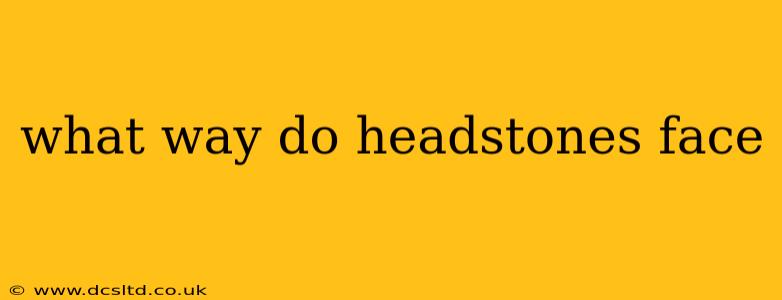The way headstones face isn't arbitrary; it's a blend of tradition, practicality, and sometimes, specific religious or cultural practices. While there's no single universal rule, several factors influence the orientation of these significant markers. Let's explore the common reasons and some exceptions.
Why Do Headstones Typically Face East?
The most prevalent practice is for headstones to face east. This stems from the Christian tradition, connecting the positioning to the rising sun, symbolizing resurrection and the promise of eternal life. The imagery of Christ rising from the east reinforces this association. Many cemeteries, particularly older ones, reflect this eastward orientation.
What About Other Orientations? Are There Exceptions?
While east-facing is the norm in many Christian cemeteries, several factors can lead to variations:
H2: Do Headstones Always Face East in Non-Christian Cemeteries?
No, not all cemeteries adhere to the east-facing tradition. In non-Christian contexts, or in cemeteries with a mix of faiths, other orientations are common. Practical considerations, such as the layout of the land or existing graves, can override any specific religious guidance. The overall design of the cemetery itself will influence the direction of individual headstones.
H2: Does the Layout of the Cemetery Affect Headstone Orientation?
Absolutely. The physical topography and existing burial plots greatly influence the direction headstones face. Cemeteries built on sloping land, for example, might have headstones arranged along contours to maintain stability and prevent erosion. Similarly, pre-existing grave layouts may dictate the direction of new headstones to maintain a coherent and organized aesthetic.
H2: Are There Any Cultural or Regional Variations in Headstone Placement?
Yes. Cultural and regional practices can impact the way headstones are placed. Some cultures may have specific traditions related to the positioning of graves and memorials. These traditions might not align with the east-facing norm. Researching the specific cultural background of a cemetery can shed light on any unique practices.
H2: Does the Type of Headstone Influence Its Placement?
The type of headstone itself doesn't typically dictate the direction it faces. However, the size and shape of the headstone might influence its placement within a row or section of the cemetery to maintain balance and visual appeal. Larger or more elaborate monuments might require additional space and positioning considerations.
H2: What if a Headstone is Facing a Different Direction? Does it Mean Something?
A headstone facing a different direction likely reflects the historical context of the cemetery or specific circumstances surrounding the burial. It might be due to practical constraints, a different religious tradition, or simply the layout choices made at the time of burial. Unless there's additional information available about the burial site, it's often impossible to definitively determine the significance of a non-east-facing headstone.
Conclusion: The Complexity of Headstone Orientation
The direction a headstone faces isn't simply a matter of chance. It's a complex interplay of tradition, practicality, religious belief, and cemetery design. While east-facing remains a prevalent practice, particularly in older Christian cemeteries, it's crucial to remember that exceptions exist and context is key to understanding the orientation of any given headstone.
